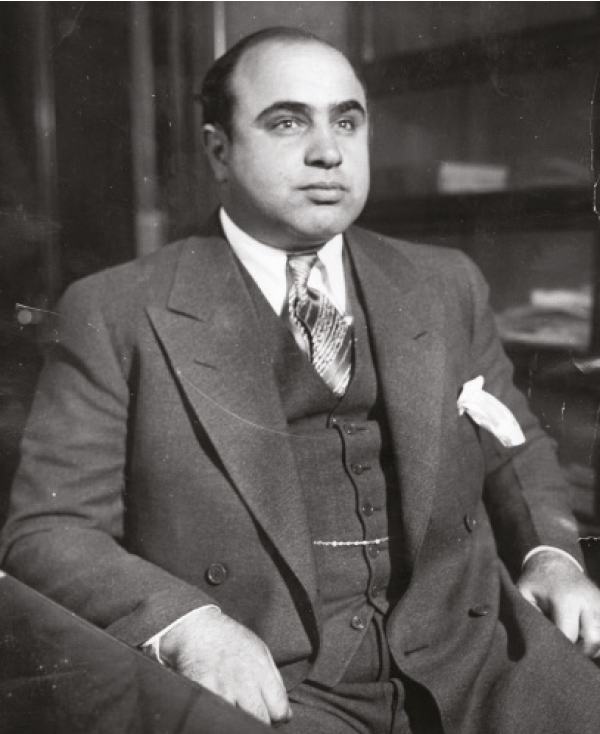
The 1929 Valentine’s Day Massacre in Chicago is generally regarded as being planned by Al ‘Scarface’ Capone. He is pictured here in February 1931 after being arrested for vagrancy by the FBI. He was ultimately charged with tax evasion and served eight years in prison. Photo courtesy of FBI.
By Eoin Meegan
With Valentine’s Day just around the corner, you may think it’s all about chocolates and roses and, hopefully, for you it will be. However, there is a much darker side to this day.
On February 14th in 1349 in Strasbourg (now the de-facto capital of the European Union) a terrible event happened that should stain the day forever. In a pogrom, several hundred Jews were publically burned to death, and hundreds more expelled from the city. This came to be known as St Valentine’s Day massacre.
This was the year after the Black Death swept through Europe and paranoia was probably at an all-time high. For some unknown reason, the residents of the city blamed the Jews for the plague.
A rumour seems to have spread that they poisoned the well and following the pogrom, strict laws were enforced to restrict Jews from trading. Sadly, these weren’t repealed until the time of the French Revolution. It is a timely reminder that racism and anti-Semitism didn’t start in a beer cellar in Bavaria.
However, the citizens of Strasbourg redeemed themselves in 1939, when just as the Nazis were about to invade the city they helped all the Jews move to safer towns.
Then there is the more well-known Valentine’s Day massacre in Chicago, 1929, when members of Al Capone’s gang gunned down seven unsuspecting members of a rival gang, virtually giving Capone control of the city. This was at the time of the prohibition wars. The weapon used that day was the Thompson gun, a submachine gun that could fire up to seventy rounds rapidly, and had become the signature weapon of the various gangs.
This atrocity was to have a direct bearing on Congress passing the National Firearms Act of 1934, when Franklin D. Roosevelt became president, banning the Thompson; effectively the first gun control bill in the US. Now if only we could elicit the same response to the deaths of school children we might all live in a safer world.
Even the day itself is mired in blood, as it was named after a Christian saint, Valentine, who was beheaded around the third century. He was made a saint in the fifth century and his day established as February 14 by Pope Gelasius 1 (Valentine’s relic is housed in Whitefriars Church, Aungier Street where he has a shrine.)
So, considering the day has such a terrible reputation, how did it become associated with love? Well, the explanation for this may lie in an ancient Roman festival called the Lupercalia, literally the festival of the wolf. The wolf was a sacred animal for the Romans as they believed the founder of Rome was suckled by a wolf.
The rites of the Lupercalia were celebrated between the 13th to the 15th of February each year, when priests of the Lupercali would sacrifice a goat and cut its skin into strips. Then they would proceed to gently strike sheaves of corn and crops with the skins, believing by doing so a good crop was assured later in the year.
However, it was also believed that it could help women who wanted to become pregnant or perhaps meet a suitable mate. So, large groups of women would go out into the street and ask the priests to strike them with the strips as well. Later, these women put their names into an urn and were paired up with bachelors for the duration of the festival. Often, the arrangement ended in marriage.
So, we see that the feast of the Lupercalia was also an ancient fertility festival, dedicated to Faunus, the Roman god of agriculture, which may explain how it became associated with love, marriage, and the pairing of couples.
Then during the Middle Ages and the Renaissance, Europe saw a revival of many ancient Roman customs, particularly love poetry. This wasn’t love poetry as we would think of it today, but followed a prescribed pattern that played with unrealistic idealisation of the feminine.
Poets such as Petrarch, Dante, Wyatt, Sidney, and Andrew Marvell began to write in imitation of, and in tribute to, the great Roman originals, Catullus, Propertius and Ovid. This was the era of the troubadours from Southern France, of amour courtois (courtly love) when many of the tropes of love that have now become commonplace were first created.
Even the word itself, ‘romance,’ derives from the word Roman, and carries darker and more menacing undertones than today’s doe-eyed equivalent. The first Hallmark cards came out in 1913 and from then on it has become the commercialised splurge it is today, with cards and plastic red hearts springing up in shop windows from January. But love it or loathe it, and despite its gory past, I guess we’re stuck with it.
And if all that didn’t disturb you too much, NewsFour would like to wish you and your loved one a very happy, and peaceful, Valentine’s Day.



